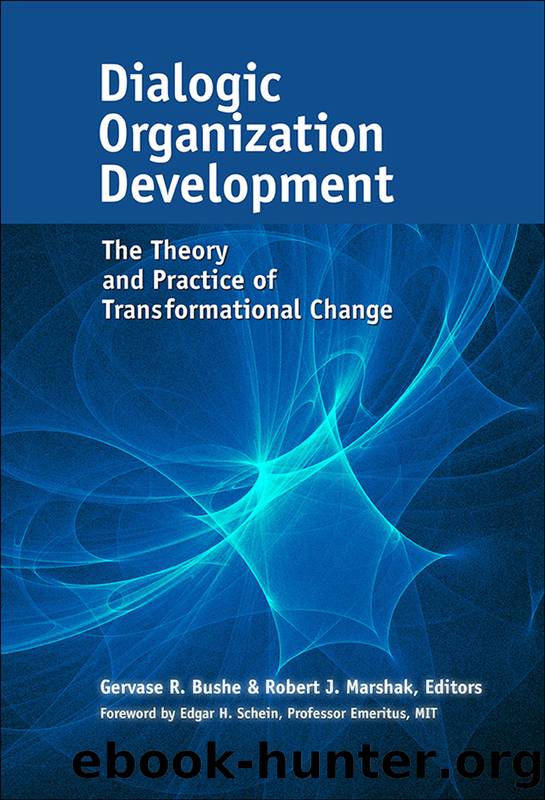Dialogic Organization Development by Gervase R. Bushe & Robert J. Marshak

Author:Gervase R. Bushe & Robert J. Marshak
Language: eng
Format: epub
Publisher: Berrett-Koehler Publishers
Published: 2015-01-15T00:00:00+00:00
Scene-Setting Activities
I believe that it is important that we had these intensive meeting sessions. If we had met every Thursday for two hours in the morning at the city hall then it wouldnât have worked as it did.
When preparing an event it is important to think of scene-setting activities. These can be very different from project to project and cover the different considerations one can make in relation to crafting a coherent narrative for the process. A first consideration is to imagine what kind of conversations the participants, including the Dialogic OD consultant, need to pursue in order to achieve the desired outcomes. Then one needs to consider where these conversations can take place and how much time is needed. Are there any special requirements? How would I like the room arranged? The requirement is basically to be mindful that everything matters; how one orchestrates conversations may support or hinder what one hopes to achieve.
As basic as these thoughts may be, all too often people are not paying any particular attention to them. For example, think of a university as a scene for learningâare things optimal? As a consultant I have worked at hundreds of locations, in countries as different as China, Greenland, the United States, and the Scandinavian countries. The differences in how a culture expresses its practical as well as aesthetic preferences are enormous. If you consider how much money is spent on bringing people together in organizations for special events or training, it is a dimension of OD consulting that needs constant attention. It will be a poor start to arrive for a big organization meeting, with people who have traveled long distances, and then realize that no one has arranged breakfast, the audiovisual equipment is not working, the tables and chairs in the room are in a mess, or the room is too small and there is no space to move around. For the people attending, making sure that such simple things work well is on the shoulders of the consultant even though the client organization may have promised to arrange them.
In our case example I needed good premises for group sessions, which included a room large enough to hold the group. I knew that I wanted them to work in many different dialogic constellations, so I preferred round tables, with white tablecloths and large sheets of paper so that they could write on the table yet keep it elegant with a clean look. Audiovisual facilities should be in place and the exterior of the room should be welcoming and stimulate conversations. There also needed to be a coffee station, armchairs, high tables, and chairs. I had been assured that there were plenty of flip charts, pens, Post-Its, and the like for creative activities. A good breakfast with fresh homemade bread and cappuccinos and a nice buffet for lunch were also provided. Breakfast was not extravagant, but it supported an implicit story and experience that everything was arranged with detail in mind. The best response one
Download
This site does not store any files on its server. We only index and link to content provided by other sites. Please contact the content providers to delete copyright contents if any and email us, we'll remove relevant links or contents immediately.
Bad Blood by John Carreyrou(6559)
Rich Dad Poor Dad by Robert T. Kiyosaki(6414)
Principles: Life and Work by Ray Dalio(6233)
Playing to Win_ How Strategy Really Works by A.G. Lafley & Roger L. Martin(5941)
Management Strategies for the Cloud Revolution: How Cloud Computing Is Transforming Business and Why You Can't Afford to Be Left Behind by Charles Babcock(4528)
The Confidence Code by Katty Kay(4190)
Thinking in Bets by Annie Duke(4154)
American Kingpin by Nick Bilton(3761)
Delivering Happiness by Tony Hsieh(3369)
Project Animal Farm: An Accidental Journey into the Secret World of Farming and the Truth About Our Food by Sonia Faruqi(3179)
The Power of Habit by Charles Duhigg(3063)
The Tyranny of Metrics by Jerry Z. Muller(3008)
Brotopia by Emily Chang(3002)
Mastering Bitcoin: Programming the Open Blockchain by Andreas M. Antonopoulos(2983)
The Marketing Plan Handbook: Develop Big-Picture Marketing Plans for Pennies on the Dollar by Robert W. Bly(2978)
I Live in the Future & Here's How It Works by Nick Bilton(2940)
The Content Trap by Bharat Anand(2864)
Building a StoryBrand by Donald Miller(2844)
Applied Empathy by Michael Ventura(2839)
